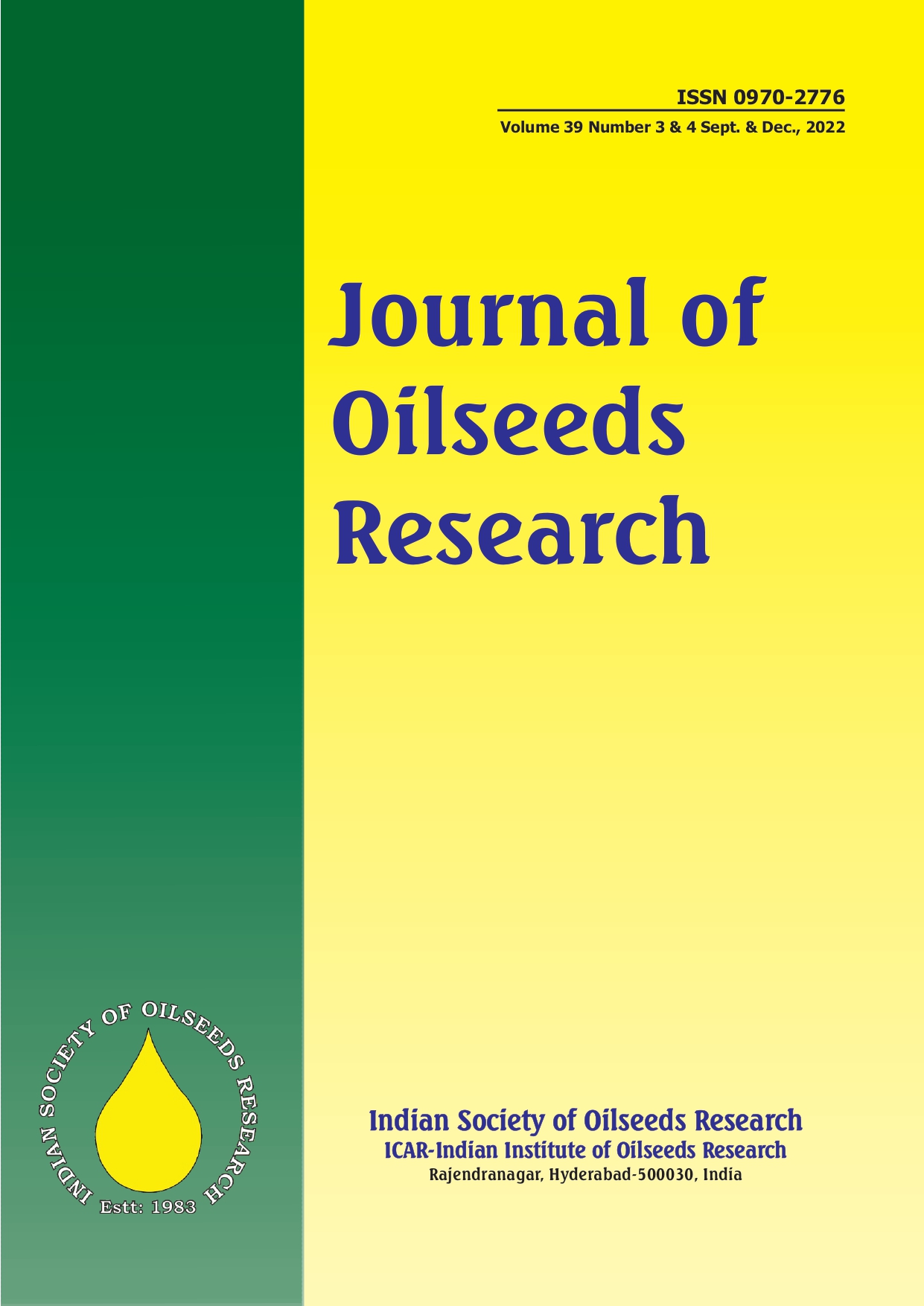Integration of bioagent, Bacillus subtilis Bbv57 and fungicides for the management of foliar diseases of groundnut (Arachis hypogaea L.)
INTEGRATION OF BACILLUS SUBTILIS BBV57 AND FUNGICIDES FOR FOLIAR DISEASES OF GROUNDNUT
136 / 1
Keywords:
Groundnut, Integrated Disease Management, Late leaf spot, RustAbstract
Groundnut or Peanut (Arachis hypogaea L.) is a major oilseed crop widely grown in major tropical and sub-tropical regions oftheworld. Disease occurrence pose a majorthreat in groundnut cultivation. Among the biotic stresses, foliar fungal diseases viz., early leaf spot (ELS) caused by Cercospora arachidicola Hori, late leaf spot (LLS) caused by Phaeoisariopsis personata (Berk. & Curt.) V.Arx (=Mycosphaerella berkeleyi Jenkins) and rust caused by Puccinia arachidis Speg. are the most widely distributed and economically important diseases of groundnut and account for more than 50% yield loss. Field experiments were conducted during kharif 2021 and rabi/summer 2021-22 for the management of foliar diseases in groundnut using bioagent, Bacillus subtilis Bbv57
talc formulation and fungicides. The results ofthe field experiment conducted during kharif 2021 revealed that seed treatment with Bacillus subtilis Bbv57 talc formulation @ 10 g/kg seed followed by foliar spray of Tebuconazole 50% + Trifloxystrobin 25% @ 1 g/l at 40 and 60 DAS was effective in managing the foliar diseases of groundnut with the late leaf spot (20.9 PDI) and rust (12.3 PDI) as compared to control which recorded late leaf spot of 71.4 PDI and rust of 52.1 PDI respectively. The maximum pod yield of 2361 kg/ha and haulm yield of 2764 kg/ha were observed in the effective treatment; whereas minimum pod yield of 1836 kg/ha and haulm yield of 1984 kg/ha were observed in the control. Similar trend was observed during rabi/summer 2021-22.
Downloads
References
Balode A 2010. Effect of tricodermin, biological product against Botrytis in horticultural crops. Acta horticulture, 877:1583-1588.
Birthal P S, Parthasarathy Rao P, Nigam S N, Bantilan M C S, Bhagavatula S 2010. Groundnut and Soybean Economics in Asia: Facts, Trends and Outlook. International Crops Research Institute for the Semi-Arid Tropics, Patancheru, Andhra Pradesh, India, p. 92.
Chaudhari P B, Shah S K, Chaudhary K V, Chaudhary S F and Desai A G 2021. Effect of potassiumon chemical composition, uptake and soil properties of groundnut (Arachis hypogaea L.) grown in loamy sand soil. Journal of Oilseeds Research, 38(1): 49-53.
Dandnaik B P, Patil D T, Chavanand M H, Dandnaik A B. 2009. Chemical control of stem rot of groundnut caused by Sclerotium rolfsii. Journal of Mycology and Plant Pathology, 39: 185.
De R K, Dwivedi R P, Udit Narain. 2003. Biological control of lentil wilt caused by Fusarium oxysporum fsp. lentis. Annals of Plant Protection Sciences, 11: 46-52.
Dudi J, Lodha P C. 2003. Compatibility ofseed dressing fungicides with rhizobium in groundnut. National seminar: Stress Management in Oilseeds, 2003, Jan 28-30, p. 24-25.
Dutta P, Das B C. 2002. Management of collar rot of tomato by Trichoderma spp. and chemicals. Indian Phytopathology, 55: 235-237.
Eswara Reddy N P, Venkateswara Rao K. 1999. Chemical control of Phaeospariopsis leaf spot of groundnut. Journal of Plant Disease and Protection, 106:507-511.
Grichar W J, Jaks A J, Woodward J. 2010. Using prothioconazole plus tebuconazole for foliar and soil borne diseases control in Texas peanut. Crop Management. CM--0405-02-RS.
Hagan A K, Campbell H L, Bowen K L, Wells L, Goodman R. 2010. Managing early leaf spot and stem rot with reduced fungicide inputs on disease resistant peanut cultivars. Peanut Science, 37: 129-136.
Hegde Y R, Ravichandran S, Keshgond R. 2016. Bioefficacy of new molecules against fungal foliar diseases of groundnut. Journal of Pure and Applied Microbiology, 10: 635.
Jadon K S, Thirumalaiswamy P P, Vinod Kumar, Koradia V G, Padavi R D. 2017. Integrated management of major foliar and soil borne diseases of pea nut (Arachis hypogeae L.) with fungicides, Trichoderma and Castor cake. Int. J Curr. Microbiol. App. Sci, 6(12): 1884-1899.
Nataraja M V, Jadon K S, Holajjer P, Thirumalaisamy P P, Jasrotia P, RamDutta. 2014. Integrated Pest and Disease Management in Groundnut. Directorate of Groundnut Research, Technical bulletin, p. 19.
Ramkishore R, Singh J. 2008. Evaluation of fungicides against Fusarium oxysporum fsp. lentis of linseed. Anals of Plant Protection Sciences, 16: 165-167.
SubrahmanyamP, McDonald D, Waliyar E, ReddyLJ, NigamS N, Gibbons R W, Thind T S. 2008. Screening methods and sources of resistance to rust and late leaf spot of groundnut (In En. Summaries in En, Fr, Sp, and Pt.). Information Bulletin no. 47. Patancheru 502 324, Andhra Pradesh, India: International Crops Research Institute for the Semi-Arid Tropics. 2008, p. 24.
Tilak I S and Bhat R S 2021. High yielding mutants from the introgression lines of groundnut (Arachis hypogaea L.). Journal of Oilseeds Research, 38(2): 132-136.
Wann D Q, Tubbs R S, Culbreath A K. 2011. Genotype and approved fungicides evaluation for reducing leafspot diseases in organically-managed peanut. Plant Health Progress. (October): PHP-2010-1027-01-RS, 2011.
